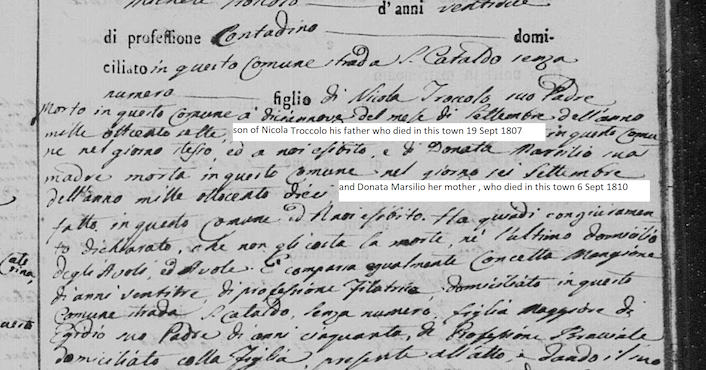
After more than three decades of Italian research, I thought I knew it all. Actually, I know I don’t — know it all — but I also don’t spend a lot of time looking again at the same records I have already reviewed and set to rest.
Recently I saw a YouTube interview by Bob Sorrentino on his “Italian Roots and Genealogy” channel. I was interviewed for this channel about a year ago on the topic of “Researching Triggiano to Chicago.” A number of notable Chicagoans like Dominic Candeloro and Carla Simonini have also been on this channel. But a more recent video made realize I had to pay closer attention to the details.
The video I saw, and I highly recommend, is called “Find Secrets to Italian Genealogical Records.” Just go to YoutuTe and search for this phrase. In this video, Bob Sorrentino interviewed a librarian and academic researcher named Katherine Pennavaria. The purpose of this column is not to rehash her video, but I recommend everyone take an hour and watch it. Katherine discussed a lot of different topics but the one I want to point out is about data I never noticed on marriage records, partly because this data was not on the marriage records for my town. I’ll explain.
As a starting point, I should remind my readers that the usual records that we can get to from a FamilySearch center usually go no farther back than 1809. For some reason, they did not keep records until 1820 in Sicily. There may be exceptions, but most civil records start at those years. So when I see a full birth date from before 1809, I usually think that the researcher had been to Italy, and had found the record in the Italian Catholic Church records. That is how I found mine. Others may have paid a professional to do this work for them. Either way, to get a birth or death date from before 1809, you really have to go to Italy and work directly.
I start showing full dates in my file, however, from the 1780s, 1790s, 1800s. Some of the data came from a great website called bariancestors.com by John Ruscigno. John has entered data from several towns in Bari and was gracious enough to send some to me to fill in some descendant lines. So I’m going through these in order to make sure I know the source. I want to record in my records where John found these dates. When I checked the site, it referenced marriage records of either the couple who were born before 1809, or it was the marriage of one of their children.
After seeing Katherine’s video, I went to the marriage records John referred to in his site and lo and behold, the marriage records had data on the second or even third page, where they refer to the birth dates of the bride and groom, or they refer to the death dates of the parents of the bride or groom. So if you get the right marriage record, you can get the death dates for up to four of their parents! Even if the death date is after 1809, you don’t have to look year by year! You can just go to that year and find the death record. What a great find!!
So armed with this new source, I go back to my Triggiano marriages to see if I can find any missing births or deaths, and…..(dirty word deleted)…..they don’t say the dates. They list the documents they had received to certify the marriage. “Atti di nascita di sposo. Atti di nascita di sposa. Att di morti di padre dello sposo” etc. But no dates. (another dirty word, worse than the last one, deleted) So I backtracked to the specific sources listed in his site, which were from other towns. And, again lo and behold, I see the dates he had in his data. “Atti di nascita di sposo, ventinove di luglio millesettecentottantatre”. That translates to “Act of birth of the groom, July 29th 1783”. There were quite a few more just like it, including death dates of the parents of the bride or groom who had died before this marriage took place.
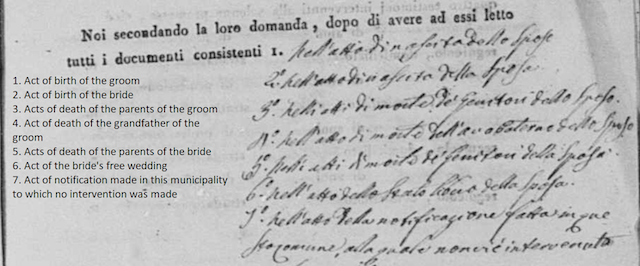
Two things to note at this point.
1) these wonderful pieces of data do not go on forever. Only the marriages from the 1810s or 1820s have all this extra info, maybe later. The marriage formats change every few years, and in many towns, they eliminated the dates, even if they listed the various documents that you can’t see. Some towns, like my Triggiano, never put the birth or death dates on any of their marriages. So the key is for you to check the marriage records of the early 1800s for your town to see if this extra data is on it or not.
2) This is a secondary source. The actual births and deaths referenced on these marriages should ideally be located on the original church sacramental records, if possible. The good news is that you will be able to find them by date rather than just hunting all over the place when you finally get to your Italian church. But if you find a date on one of those marriages, you should source them by referring to the marriage record you found that date on. If you can find other marriages in that family, you can further corroborate that death date you found for one of the parents. Yes it’s the same date, but if you find it on six marriages of the kids, you have 6 sources for that date even if it isn’t a “primary source” that was written at the time of the event.
Even if your town didn’t list those extra dates on the marriages, but one of their kids married in a different town, go get that marriage and see if it has the extra dates.
 Fra Noi Embrace Your Inner Italian
Fra Noi Embrace Your Inner Italian


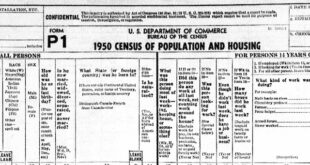
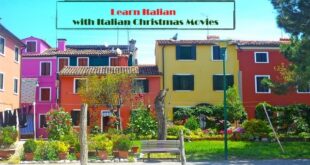
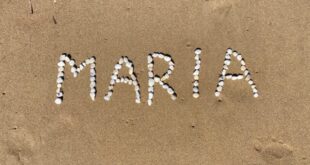
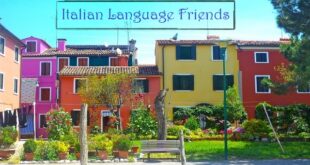
Hi Dan. I have been successful, especially with Sicilian marriages, by hunting down the marriage processetti (allegretto) for those marriages. I’ve seen baptisms, written in Latin, for the bride & groom. And also last rites docs for parents which then provide names of grandparents. Love reading your column. Tony Maro